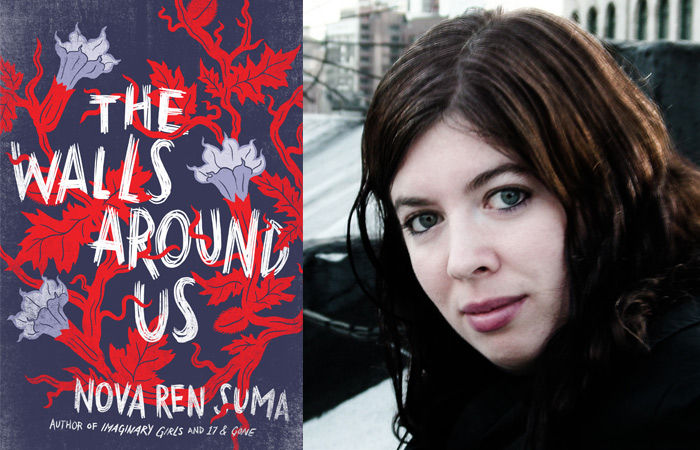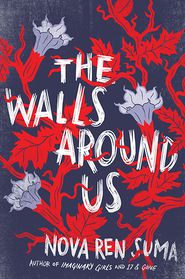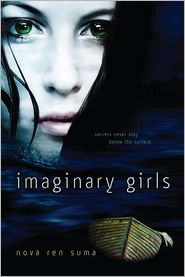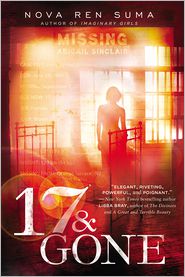Nova Ren Suma Talks The Walls Around Us, 2015 Must-Reads, and Orange is the New Black

Beautiful. Haunting. Magical. These are the kinds of words you’ll find attached to pretty much every review of any book by Nova Ren Suma, and if you’ve read any of her work, you know exactly why. If you haven’t, the release of her newest, The Walls Around Us, is a perfect excuse to start. Suma is a master of YA that combines darkness and light, magic and realism, thoughfulness and a dreamlike quality. Whether she’s deftly depicting the love between sisters, as in Imaginary Girls, or capturing the tenuous, frightening cusp of the end of adolescence, as in 17 & Gone, Nova Ren Suma has always been an author to watch, and her third YA only further proves it. I got to talk to the author herself about her fabulous new book, where she gets her writing done, and what comes next.
Ordinarily I’d never ask an author this, but I suspect you can put it into far better words than I’d ever be able to. How do you answer what The Walls Around Us is “about”?
The Walls Around Us
The Walls Around Us
Hardcover $17.95
The Walls Around Us is a ghostly story of suspense set in a girls’ juvenile detention center and a ballet school, told in two voices—one still living, and one dead. It’s about guilt and innocence and what happens when one gets mistaken for the other. It’s also a bit strange, like I am.
The Walls Around Us has been (so, so aptly) called “Orange is the New Black Swan.” In the YA author version of Orange is the New Black, who would you be and why? (Bonus points if you can lay out any other YA author friend inmates.)
I often feel misunderstood like Suzanne (Crazy Eyes), but in reality, if I were locked away in prison, the truth is I would be so incredibly intimidated and shy, I’d be unable to squeak out any words. So just call me Norma.
The characters of OITNB are so distinctly themselves—which makes me admire the show so much, such good writing—that I can’t seem to slip anyone I know into their roles. To my mind, they’re inhabited so well already. But if anyone reading this interview wants to help build the YA author Orange Is the New Black cast, I’d love to see it. So long as I don’t end up stuck being Larry.
I love the shoutouts to other YA books and authors in The Walls Around Us, including the work of Libba Bray, and Speak by Laurie Halse Anderson. How did you choose your mentions?
All the titles and authors on the book cart that Amber wheels around the Aurora Hills Secure Juvenile Detention Center made an impact on me as a young reader or developing writer in some way. Books from my deep past are mentioned (The Clan of the Cave Bear, Sister Carrie, and more), along with authors who’ve influenced me over the years (Sara Zarr, Isabel Allende, and more), and that’s why I made sure they appeared in the prison library. Every book is there for a reason, personal to me.
The book is, among other things, heavily ballet-centric in Violet’s narration, in a way that felt both highly accessible and really authentic to this completely inept-at-dance interviewer. What’s your experience with dance? Or was this all thorough research?
The Walls Around Us is a ghostly story of suspense set in a girls’ juvenile detention center and a ballet school, told in two voices—one still living, and one dead. It’s about guilt and innocence and what happens when one gets mistaken for the other. It’s also a bit strange, like I am.
The Walls Around Us has been (so, so aptly) called “Orange is the New Black Swan.” In the YA author version of Orange is the New Black, who would you be and why? (Bonus points if you can lay out any other YA author friend inmates.)
I often feel misunderstood like Suzanne (Crazy Eyes), but in reality, if I were locked away in prison, the truth is I would be so incredibly intimidated and shy, I’d be unable to squeak out any words. So just call me Norma.
The characters of OITNB are so distinctly themselves—which makes me admire the show so much, such good writing—that I can’t seem to slip anyone I know into their roles. To my mind, they’re inhabited so well already. But if anyone reading this interview wants to help build the YA author Orange Is the New Black cast, I’d love to see it. So long as I don’t end up stuck being Larry.
I love the shoutouts to other YA books and authors in The Walls Around Us, including the work of Libba Bray, and Speak by Laurie Halse Anderson. How did you choose your mentions?
All the titles and authors on the book cart that Amber wheels around the Aurora Hills Secure Juvenile Detention Center made an impact on me as a young reader or developing writer in some way. Books from my deep past are mentioned (The Clan of the Cave Bear, Sister Carrie, and more), along with authors who’ve influenced me over the years (Sara Zarr, Isabel Allende, and more), and that’s why I made sure they appeared in the prison library. Every book is there for a reason, personal to me.
The book is, among other things, heavily ballet-centric in Violet’s narration, in a way that felt both highly accessible and really authentic to this completely inept-at-dance interviewer. What’s your experience with dance? Or was this all thorough research?
Imaginary Girls
Imaginary Girls
In Stock Online
Paperback $13.99
I started ballet when I was six years old and quit when I was sixteen because all I wanted to do was hang out and waste time with my friends. Not the most mature of decisions. But in writing the scenes from Violet’s perspective, I channeled my own experience as a dancer at small-town dance studios (I also studied modern and jazz and tap, and I was once a terrible understudy for the Artful Dodger in a community-theater performance of Oliver!)—though I never had the talent or grit to pursue becoming a professional dancer. My last ballet recital was The Firebird. I was one of the maidens in the enchanted garden who tossed golden apples in the air and tried very hard not to drop them while onstage. So the ballet scenes are plucked from my memories of those years…then I added in some murders.
You’re notoriously involved in and in attendance at writers’ colonies. For those of us who’ve never been, what are they like and what about them suits you so well?
I started ballet when I was six years old and quit when I was sixteen because all I wanted to do was hang out and waste time with my friends. Not the most mature of decisions. But in writing the scenes from Violet’s perspective, I channeled my own experience as a dancer at small-town dance studios (I also studied modern and jazz and tap, and I was once a terrible understudy for the Artful Dodger in a community-theater performance of Oliver!)—though I never had the talent or grit to pursue becoming a professional dancer. My last ballet recital was The Firebird. I was one of the maidens in the enchanted garden who tossed golden apples in the air and tried very hard not to drop them while onstage. So the ballet scenes are plucked from my memories of those years…then I added in some murders.
You’re notoriously involved in and in attendance at writers’ colonies. For those of us who’ve never been, what are they like and what about them suits you so well?
17 & Gone
17 & Gone
Paperback $9.99
I love that this makes me “notorious.” I’m not dangerous enough to be notorious for anything else. Colonies or residencies are places that offer writers—and artists, and composers—the space and time to create. That’s the gift, and it’s often given for free. At colonies, you get your own writing studio and then gather together with the other artists during breakfast and dinner for conversation and sharing work. There are no assignments. There is no one looking over your shoulder. Your time is yours. It’s intensely inspiring and very, very productive for me (especially when there is no internet in my writing studio). The opening of The Walls Around Us was written at the Millay Colony in Austerlitz, New York, and then the outline was written at the Hambidge Center in Rabun Gap, Georgia. Finally, a good part of the first draft of The Walls Around Us was written at the MacDowell Colony in Peterborough, New Hampshire—I wrote 43,258 words of the book there in a span of two weeks. I can’t imagine what this book would be without those gifts of time, and I’m very grateful for the support.
The Walls Around Us has a truly striking cover that ties in with the book beautifully. What was the process of creating it like, and how involved were you?
Here’s how involved I was in the creation of my fantastic and utterly perfect book cover: I was sitting at my desk idly one day when an email came in from my editor at Algonquin with this beauty attached. I could not believe my luck. The designer is Connie Gabbert and I loved how she picked a significant yet subtle element from inside the story—those climbing vines—and made a true piece of art with it. I couldn’t love this cover more. It’s everything I wanted and didn’t know how to articulate.
The book is full of gorgeous epigraphs by authors such as Margaret Atwood, Edna St. Vincent Millay, and Heather O’Neill. Could you tell us a little more about them and why they’re such perfect for choices for The Walls Around Us?
Just like the book cart and the prison library, these epigraphs are connected to me quite personally. These are books and writers that led me to be the writer I am today, all favorites of mine from different points in my life. I’ll start with the very first one and let you come to the others on your own, as you read the book. I discovered The Handmaid’s Tale on my mother’s bookshelf when I was twelve years old. This book, and Margaret Atwood’s other novels, blew my mind and caught my heart. These were stories about girls and women written by a woman…and it was the first time I realized this could be. That women’s and girls’ stories were worthy of being made into books. That maybe I, a girl, might be able to grow up to be a writer, too. I was so honored when Margaret Atwood—via her assistant, of course—gave me permission to use this quote as an epigraph in The Walls Around Us. My twelve-year-old self could not stop shaking.
What can you tell us about what’s next for the Works of Nova Ren Suma?
I’m writing a new novel now and all I can tell you is that it will be my next book with Algonquin and I wish it were more fully formed and had more of a face so I could tell you more. Alas. But you can also find me with a short story called “The Birds of Azalea Street” in the upcoming YA horror anthology Slasher Girls & Monster Boys, coming in August from Dial/Penguin. My story is dark magical realism in suburbia, starring girls of course, and very, very me.
What other books are you excited for releasing this year?
I was honored to blurb some wonderful books this year: My Heart and Other Black Holes, by Jasmine Warga (now available), is gut-wrenching and extraordinary. Bone Gap, by Laura Ruby (now available), is surreal and exquisite. The Weight of Feathers, by Anna-Marie McLemore, (coming September 2015) is hypnotic and dazzling. And Blood & Salt, by Kim Liggett (also coming September 2015), is darkly seductive and gorgeous.
I’ll leave you with a book I want everyone to read—EVERYONE. It’s the brilliant and stunning and important new novel by Courtney Summers: All the Rage, coming April 14 from St. Martin’s Press. Please read this book so we can talk about it.
I love that this makes me “notorious.” I’m not dangerous enough to be notorious for anything else. Colonies or residencies are places that offer writers—and artists, and composers—the space and time to create. That’s the gift, and it’s often given for free. At colonies, you get your own writing studio and then gather together with the other artists during breakfast and dinner for conversation and sharing work. There are no assignments. There is no one looking over your shoulder. Your time is yours. It’s intensely inspiring and very, very productive for me (especially when there is no internet in my writing studio). The opening of The Walls Around Us was written at the Millay Colony in Austerlitz, New York, and then the outline was written at the Hambidge Center in Rabun Gap, Georgia. Finally, a good part of the first draft of The Walls Around Us was written at the MacDowell Colony in Peterborough, New Hampshire—I wrote 43,258 words of the book there in a span of two weeks. I can’t imagine what this book would be without those gifts of time, and I’m very grateful for the support.
The Walls Around Us has a truly striking cover that ties in with the book beautifully. What was the process of creating it like, and how involved were you?
Here’s how involved I was in the creation of my fantastic and utterly perfect book cover: I was sitting at my desk idly one day when an email came in from my editor at Algonquin with this beauty attached. I could not believe my luck. The designer is Connie Gabbert and I loved how she picked a significant yet subtle element from inside the story—those climbing vines—and made a true piece of art with it. I couldn’t love this cover more. It’s everything I wanted and didn’t know how to articulate.
The book is full of gorgeous epigraphs by authors such as Margaret Atwood, Edna St. Vincent Millay, and Heather O’Neill. Could you tell us a little more about them and why they’re such perfect for choices for The Walls Around Us?
Just like the book cart and the prison library, these epigraphs are connected to me quite personally. These are books and writers that led me to be the writer I am today, all favorites of mine from different points in my life. I’ll start with the very first one and let you come to the others on your own, as you read the book. I discovered The Handmaid’s Tale on my mother’s bookshelf when I was twelve years old. This book, and Margaret Atwood’s other novels, blew my mind and caught my heart. These were stories about girls and women written by a woman…and it was the first time I realized this could be. That women’s and girls’ stories were worthy of being made into books. That maybe I, a girl, might be able to grow up to be a writer, too. I was so honored when Margaret Atwood—via her assistant, of course—gave me permission to use this quote as an epigraph in The Walls Around Us. My twelve-year-old self could not stop shaking.
What can you tell us about what’s next for the Works of Nova Ren Suma?
I’m writing a new novel now and all I can tell you is that it will be my next book with Algonquin and I wish it were more fully formed and had more of a face so I could tell you more. Alas. But you can also find me with a short story called “The Birds of Azalea Street” in the upcoming YA horror anthology Slasher Girls & Monster Boys, coming in August from Dial/Penguin. My story is dark magical realism in suburbia, starring girls of course, and very, very me.
What other books are you excited for releasing this year?
I was honored to blurb some wonderful books this year: My Heart and Other Black Holes, by Jasmine Warga (now available), is gut-wrenching and extraordinary. Bone Gap, by Laura Ruby (now available), is surreal and exquisite. The Weight of Feathers, by Anna-Marie McLemore, (coming September 2015) is hypnotic and dazzling. And Blood & Salt, by Kim Liggett (also coming September 2015), is darkly seductive and gorgeous.
I’ll leave you with a book I want everyone to read—EVERYONE. It’s the brilliant and stunning and important new novel by Courtney Summers: All the Rage, coming April 14 from St. Martin’s Press. Please read this book so we can talk about it.


